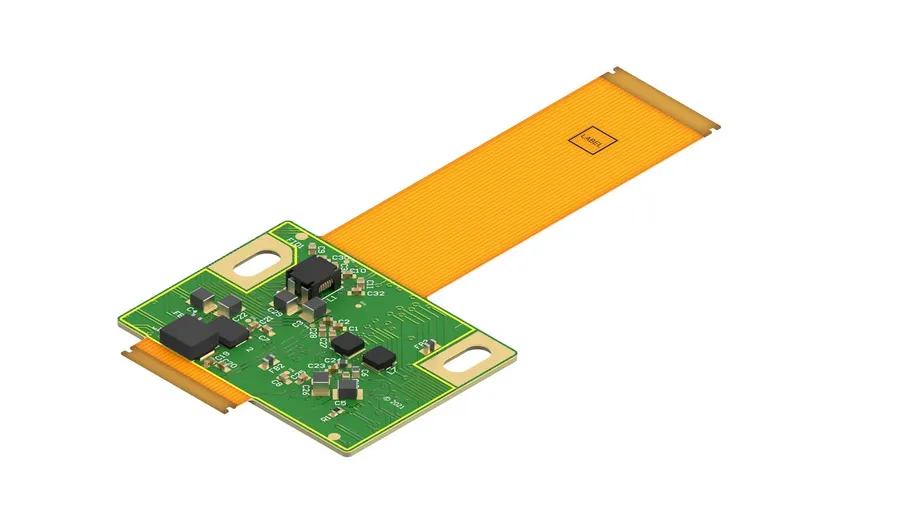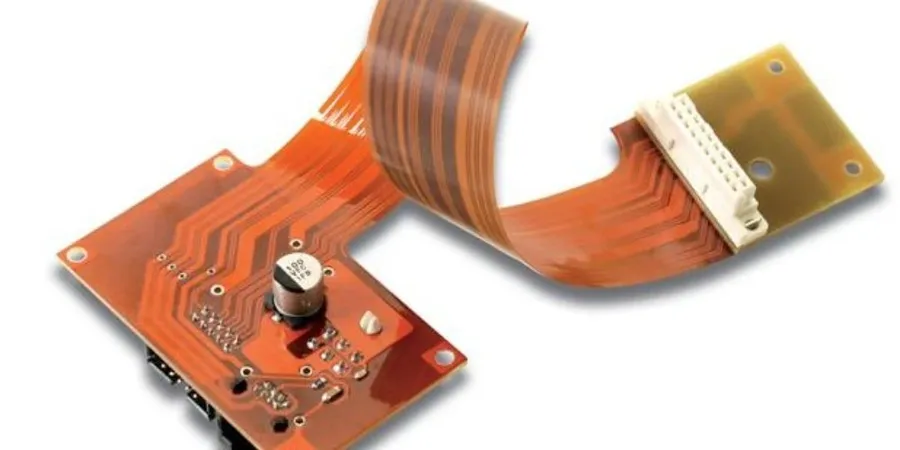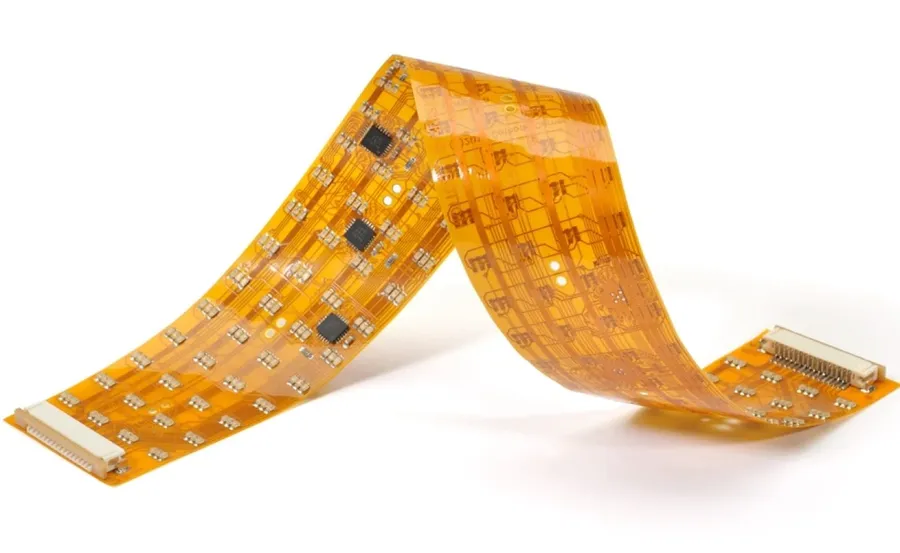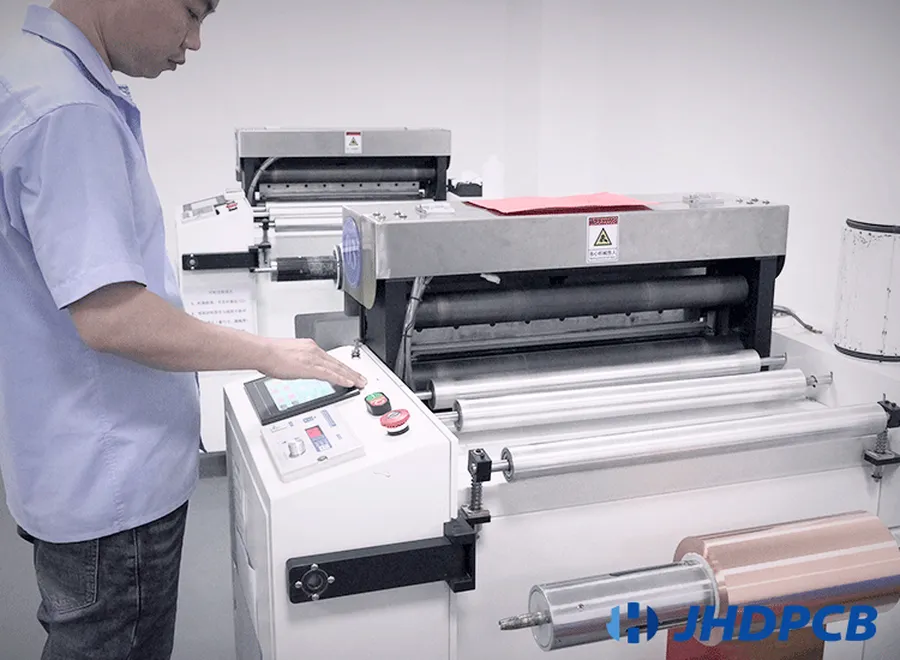Flex Printed Circuits: The Ultimate Guide to Flexible Electronics

In today's rapidly evolving tech landscape, flexibility isn't just a desirable trait—it's a necessity. Flex printed circuits, or flexible PCBs, are at the forefront of this movement, bridging the gap between rigid electronics and dynamic applications. From wearable devices to intricate medical instruments, these circuits are reshaping how we interact with technology, demonstrating a fusion of engineering and modern life, where adaptability is crucial.
What are Flex Printed Circuits?

Flex printed circuits (FPCs), also known as flexible printed circuits, are bendable electronic circuits constructed on flexible substrates, differing fundamentally from rigid printed circuit boards (PCBs). This flexibility enables unique applications where traditional rigid boards are unsuitable. FPCs are not just flexible in the literal sense; they introduce transformative capabilities in electronic design and integration.
The core structure of an FPC consists of a thin, flexible substrate material, typically a polymer film, upon which conductive traces are patterned using copper. Additional layers of adhesive and protective coatings may be added for durability and insulation. Unlike rigid PCBs, FPCs can conform to complex shapes, bend, and even fold without compromising electrical performance. This adaptability opens avenues for compact and intricate electronic designs.
| Feature | Flex Printed Circuits (FPCs) | Rigid Printed Circuit Boards (PCBs) |
|---|---|---|
| Substrate Material | Flexible Polymer (e.g., Polyimide, PET) | Rigid Materials (e.g., FR-4) |
| Flexibility | Highly Flexible, Bendable | Rigid, Cannot Bend |
| Shape Conformance | Conforms to Complex Shapes | Fixed Shape |
| Applications | Wearable tech, automotive, medical devices, aerospace | Computers, consumer electronics, industrial equipment |
| Weight | Lower | Higher |
| Durability | High bending and vibration resistance | Limited flexibility and vibration resistance |
Key Advantages of Flex Printed Circuits

Flex printed circuits (FPCs) offer a multitude of advantages over traditional rigid PCBs, primarily stemming from their inherent flexibility. These benefits translate to enhanced design possibilities, increased efficiency, and improved performance across a wide array of applications. The ability to conform to various shapes and fit into tight spaces makes them essential for modern electronic designs, where space is at a premium and design constraints are complex.
- Design Flexibility
FPCs can be bent, folded, and twisted to fit into unique and complex enclosures, offering greater design freedom compared to rigid PCBs. This allows engineers to create smaller, more compact devices that can adapt to various shapes and forms. - Space Savings
Due to their flexibility, FPCs can be used to connect components in multiple planes, reducing the overall size and weight of the electronic assembly. This is particularly advantageous in portable and wearable devices. - Enhanced Durability
FPCs often exhibit better resistance to vibrations, shocks, and extreme temperatures compared to rigid PCBs. Their flexible nature allows them to withstand mechanical stress, making them more durable and reliable in harsh environments. - Reduced Weight
The thin, lightweight nature of FPCs contributes to the overall reduction in weight of electronic products. This is critical in applications where weight is a major concern, such as aerospace, automotive and portable electronics. - Improved Reliability
FPCs reduce the number of interconnects, which decreases the chances of failure and increases the overall reliability of the electronic system. The integrated nature of flexible circuits eliminates the need for connectors, improving the system's structural integrity.
Materials Used in Flex Printed Circuit Manufacturing

The performance and reliability of flex printed circuits (FPCs) are intrinsically linked to the materials used in their construction. The selection of substrate, conductive layers, and other critical components is a pivotal decision that directly impacts the flex circuit's ability to withstand bending, temperature variations, and demanding electrical requirements. The correct choice of materials is critical to ensuring optimal functionality and longevity.
| Material | Description | Advantages | Disadvantages | Typical Applications |
|---|---|---|---|---|
| Polyimide (Kapton) | A high-performance polymer known for its exceptional thermal stability and chemical resistance. | Excellent temperature resistance, high mechanical strength, chemical resistance. | Higher cost compared to other materials, can be sensitive to moisture absorption. | High-reliability applications, aerospace, automotive |
| Polyester (PET) | A widely used, low-cost thermoplastic polymer. | Cost-effective, good chemical resistance, flexible. | Lower temperature resistance compared to polyimide, less durable. | Consumer electronics, low-cost applications, disposable devices. |
| Liquid Crystal Polymer (LCP) | A high-performance polymer with excellent electrical and mechanical properties. | Low moisture absorption, high dimensional stability, good electrical performance at high frequencies | Higher cost, can be challenging to process. | High-frequency applications, advanced communication systems. |
| Copper Cladding | The primary conductive material used for traces and vias. | Excellent electrical conductivity, readily available, good solderability. | Can be susceptible to corrosion if not protected, relatively heavy compared to other materials. | All types of flex circuit applications |
| Adhesives | Used to bond layers of the flex circuit together. | Provides mechanical bonding strength, can be conductive or non-conductive. | Can be a source of delamination if not properly applied, can outgas at high temperatures. | All types of flex circuit applications |
| Coverlays | Protective layers applied to the circuit to protect it from physical damage and moisture. | Provides physical protection, environmental protection, insulation | Adds to the overall thickness and cost. | All types of flex circuit applications |
Flex Printed Circuit Design Considerations

Designing flexible printed circuits (FPCs) demands careful attention to several factors that differ significantly from rigid PCB design. These considerations ensure the FPC functions reliably under various mechanical and environmental stresses. Key design aspects include trace routing, bend radii, conductor thickness, layer count, and environmental compatibility. A robust design is crucial for the FPC's longevity and performance in its intended application.
| Design Consideration | Description | Impact on FPC Performance |
|---|---|---|
| Trace Routing | Path and configuration of conductive traces on the flexible substrate. | Affects signal integrity, impedance, and flexibility. Improper routing can lead to signal loss or mechanical stress. |
| Bend Radii | Minimum radius to which the FPC can be bent without damage. | Determines the flexibility and service life of the FPC. Exceeding the minimum bend radius can cause conductor cracks or delamination. |
| Conductor Thickness | Thickness of the copper or other conductive layers. | Affects the current carrying capacity and flexibility. Thicker conductors offer better current capacity but reduce flexibility. |
| Layer Count | Number of conductive and dielectric layers in the FPC. | Determines the complexity and cost. Higher layer counts allow for more complex circuits but increase the thickness and reduce flexibility. |
| Environmental Factors | Temperature, humidity, and chemical exposure the FPC will encounter. | Impacts material selection and long-term reliability. Incorrect material selection can lead to material degradation and circuit failure. |
Practical design guidelines include using teardrop pads at trace junctions to reduce stress concentrations, minimizing sharp bends and corners to prevent stress risers, and ensuring proper spacing between traces to avoid shorts. The specific requirements vary by application, but following these guidelines will help ensure the reliability and longevity of the flex printed circuits.
Applications of Flex Printed Circuits Across Industries

Flex printed circuits (FPCs) have become indispensable across a wide range of industries due to their flexibility, space-saving capabilities, and reliability. This section details how FPCs are utilized in various sectors, highlighting their critical role in modern technology.
The unique attributes of FPCs, such as their ability to conform to complex shapes and withstand repetitive bending, make them ideal for applications where traditional rigid PCBs are unsuitable. This adaptability has led to their widespread adoption in diverse fields, revolutionizing product design and functionality.
| Industry | Application Examples | Specific Use Cases |
|---|---|---|
| Consumer Electronics | Smartphones, Laptops, Wearable Tech | Interconnecting displays, cameras, keyboards, and sensors in a compact and flexible manner. |
| Automotive | Advanced Driver-Assistance Systems (ADAS), In-Car Infotainment | Connecting sensors, control units, and display modules within constrained spaces of vehicles. |
| Medical | Implantable Devices, Diagnostic Equipment | Enabling miniaturization and biocompatibility in devices such as pacemakers, hearing aids, and surgical tools. |
| Aerospace | Satellite Systems, Aircraft Avionics | Providing lightweight, reliable interconnections in space and aircraft systems, reducing overall weight and improving performance. |
| Industrial | Robotics, Industrial Control Systems | Facilitating complex wiring and movement in robotic arms, machinery controls, and automation equipment. |
- Consumer Electronics
FPCs are extensively used in smartphones for connecting displays, cameras, and keyboards. They also enable the sleek design of wearable devices like smartwatches and fitness trackers. - Automotive
In the automotive industry, FPCs facilitate the integration of sensors for ADAS, power steering systems, infotainment displays, and other electronic controls. Their ability to withstand vibrations and temperature changes makes them critical for automotive applications. - Medical
Flex circuits play a vital role in medical devices, such as implantable pacemakers and hearing aids, by providing compact and biocompatible solutions. They are also found in diagnostic equipment, facilitating precise and reliable measurements. - Aerospace
In aerospace, FPCs are used in satellite systems and aircraft avionics for their lightweight nature and reliability. Their adaptability to harsh environments makes them indispensable for aerospace applications. - Industrial
Industrial automation uses FPCs to enable the complex movements of robotic arms and in control systems. Their durability and reliability in demanding environments are key to their suitability for such applications.
Flex Printed Circuit Manufacturing Processes

The fabrication of flex printed circuits (FPCs) is a complex process demanding high precision and stringent quality control. It involves a series of intricate steps from initial design to final assembly, each crucial to the functionality and reliability of the circuit.
- Design and Layout
The manufacturing process begins with a detailed design, typically using specialized CAD software. This phase defines the circuit's geometry, including trace routing, pad locations, and component placement, while adhering to the specific flexibility and performance requirements. - Material Preparation
The selected flexible substrate material, such as polyimide or PET, is carefully prepared. This may involve cleaning, drying, and applying an adhesive layer to facilitate bonding with conductive layers. - Conductor Layer Application
A thin layer of conductive material, most often copper, is applied to the substrate. This is often achieved through a sputtering or electroplating process, ensuring uniform coverage and excellent adhesion. - Photolithography
A photoresist material is applied and patterned using UV light and a photomask that defines the precise circuit design. The exposed areas become soluble, enabling the removal of unwanted material. - Etching
The exposed copper is etched away using chemical solutions. This leaves behind the desired conductive traces and pads as defined by the photoresist pattern. - Layer Lamination (for multilayer FPCs)
For circuits with multiple conductive layers, the layers are laminated together using specialized adhesives and heat/pressure. This process aligns each layer precisely, ensuring reliable interconnections and avoiding short circuits. - Drilling and Via Formation
Mechanical or laser drilling creates holes for component placement and interlayer connections (vias). These vias may be plated to provide electrical continuity between layers. - Surface Finishing
The conductive surfaces are finished to improve solderability and corrosion resistance. This includes surface treatments like HASL (Hot Air Solder Leveling) or gold plating. - Component Assembly
Electronic components are attached to the FPC using automated pick-and-place machines and precision soldering techniques. This is often the final stage of manufacturing process. - Quality Control and Testing
Throughout the manufacturing process, rigorous quality control measures are implemented to verify the physical and electrical properties of the FPC. Electrical testing, visual inspections, and dimensional checks are common to ensure every circuit meets specifications.
Flexible Printed Circuit Connectors and Assembly
The effective utilization of flexible printed circuits (FPCs) hinges significantly on the selection and implementation of appropriate connectors and assembly techniques. These elements are critical not only for ensuring reliable electrical connections but also for maintaining the mechanical integrity and overall performance of FPC-based electronic systems. The following section details these vital aspects, encompassing connector types, mounting procedures, and their influences on circuit performance.
| Connector Type | Description | Typical Application | Advantages | Disadvantages |
|---|---|---|---|---|
| ZIF (Zero Insertion Force) Connectors | Connectors that require minimal force for insertion and removal, often utilizing a clamping mechanism. | High-density applications, situations requiring frequent disconnections. | Reduces stress on FPC, easy to connect and disconnect. | Can be larger in size, more complex. |
| FFC/FPC Connectors | Designed specifically for flat flexible cables and printed circuits, often featuring a locking mechanism. | Common in consumer electronics, portable devices. | Compact size, reliable connection | Can be sensitive to misalignment, requires precise insertion |
| Soldered Connections | Directly soldering FPC traces to pads or other components. | Permanent connections in high-reliability applications. | High mechanical strength, low electrical resistance. | Difficult to repair, requires soldering expertise |
| Crimped Connectors | Connectors that use pressure to establish a connection between FPC and the connector. | Automotive applications, rugged environments. | Robust connection, suitable for harsh conditions | Requires special crimping tools, not easily disassembled |
Proper mounting and assembly of flex circuits are essential for avoiding damage and ensuring operational reliability. Mounting methods range from adhesive bonding to mechanical fasteners, each with its own set of advantages and disadvantages. Considerations must be given to stress distribution, thermal expansion, and the application’s mechanical requirements. Improper assembly can lead to issues such as trace damage, connection failures, and premature wear.
The choice of connector and assembly method directly influences the electrical performance of FPCs. Connectors can introduce contact resistance, signal reflections, and electromagnetic interference. Assembly methods can affect trace integrity and overall system robustness. Thus, meticulous design and assembly are needed to optimize FPC performance.
Frequently Asked Questions about Flex Printed Circuits
This section addresses common questions about flexible printed circuits (FPCs), clarifying their nature, applications, and design considerations. Understanding these frequently asked questions can provide clarity on the versatility and advantages of FPC technology.
- What exactly is a flex print or flexible printed circuit?
A flex print, or flexible printed circuit (FPC), is an electronic circuit fabricated on a flexible substrate, such as polyimide or polyester. This allows the circuit to bend and flex, unlike traditional rigid PCBs, while maintaining its functionality. They are characterized by their ability to conform to various shapes and dynamic environments. FPCs are also know as flex circuits. - What is flex paper?
The term 'flex paper' typically refers to the flexible substrate material used in FPCs, most commonly polyimide film (often known by the brand name Kapton), or polyester. While not paper in the traditional sense, these materials are thin, flexible sheets upon which the conductive circuit patterns are etched or printed. - What are the typical applications of flex PCBs?
Flex PCBs are incredibly versatile and are used in a wide array of applications, including consumer electronics (smartphones, wearables), automotive systems (sensors, control modules), medical devices (implantables, diagnostic tools), aerospace (avionics, satellite systems), and industrial equipment. Their flexibility, space saving, and light weight make them suitable for complex designs and demanding environments. - What does 'flex design' refer to in the context of flexible circuits?
Flex design involves specific considerations to ensure the FPC can function reliably when bent, folded, or subjected to dynamic movements. Key design parameters include minimum bend radii, trace routing to avoid stress concentrations, controlled impedance requirements, and appropriate material selection for the operating environment. - How durable are flexible printed circuits?
FPCs are designed to be highly durable, but their performance is influenced by material choice and the design. Polyimide substrates, for instance, have high tensile strength and resistance to both temperature and chemical exposure. When designed properly, they can withstand repetitive flexing and bending with out failure. However, it's essential to adhere to bending specifications to avoid structural damage. - Are flexible printed circuits more expensive than rigid PCBs?
Generally, flexible PCBs tend to be more expensive than rigid PCBs due to the specialized materials and manufacturing processes involved. However, the overall system costs can be reduced with flex PCBs because of the reduction in number of components, the simplification of assembly steps, and the reduction in weight, which can make it a competitive choice. - Can flexible circuits be used in high-temperature environments?
Yes, flexible circuits, particularly those using polyimide substrates, can be used in high-temperature environments. Polyimide materials have a high operating temperature range, however the conductive materials such as copper traces also need to be considered, as they too can be subjected to high operating temperatures.
Future Trends and Innovations in Flex Printed Circuits
The field of flexible printed circuits (FPCs) is rapidly evolving, driven by innovations in materials, manufacturing techniques, and emerging applications. These advancements are paving the way for more versatile, durable, and integrated electronic solutions across various industries.
- Advancements in Substrate Materials
Research is focused on developing new substrate materials with improved flexibility, thermal stability, and biocompatibility. This includes exploring nanomaterials, bio-based polymers, and advanced composites. - Stretchable Electronics
A significant trend is the development of stretchable FPCs that can conform to complex shapes and withstand significant deformation without compromising performance. This is particularly relevant for wearable devices and bio-integrated electronics. - Additive Manufacturing Techniques
3D printing and other additive manufacturing techniques are being explored to create FPCs with greater design freedom and reduced manufacturing time and cost. This allows for customized and on-demand fabrication of flex circuits. - Integration with Advanced Components
Integrating FPCs with micro-electromechanical systems (MEMS), sensors, and other advanced components is expanding the range of applications and creating more compact and functional electronic systems. - Bio-Integrated Electronics
The development of biocompatible FPCs is enabling the creation of implantable medical devices and bio-integrated sensors. This holds promise for improved patient monitoring, treatment, and enhanced human-machine interfaces. - Self-Healing Electronics
The introduction of self-healing materials in flex circuits to repair micro-cracks and damage, which will extend the lifetime and durability of flex circuits for use in extreme environments.
Flex printed circuits are revolutionizing industries with their unparalleled ability to adapt to complex geometries and dynamic environments. From simple consumer gadgets to advanced medical devices, they provide innovative solutions that previously were impossible with traditional rigid PCBs. As technology progresses, the integration of flex printed circuits is set to expand, leading to more flexible, reliable, and innovative electronic devices. Understanding these circuits’ potential allows us to foresee a future where design limitations are further minimized, fostering growth and adaptation to the changing needs of the tech world.
 AnyPCBA
AnyPCBA